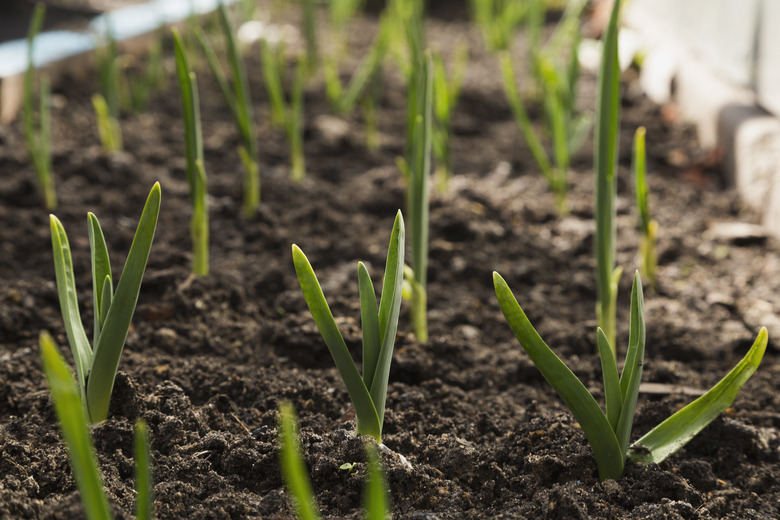How Long Does It Take For Garlic To Grow And Mature?
We may receive a commission on purchases made from links.
Fresh garlic (Allium sativum) is a delicious addition to homemade pasta dishes, soups, marinades, and more, and growing it in your garden gives you a fresh supply whenever you need it. Garlic is different than many vegetables, which go into the ground in the spring, because you typically plant it in the fall. With the fall planting schedule, it takes garlic around eight months to reach maturity from planting to harvest. Garlic grows in U.S. Department of Agriculture plant hardiness zones 4 through 9.
How to Grow Garlic
How to Grow Garlic
Fall planting is recommended for garlic to produce larger bulbs, although you can plant garlic in early spring. The bulbs need to go into the ground six to eight weeks before the ground freezes. That means you'll plant the garlic between late September and November, depending on your location and the typical freeze dates. Your garlic needs to go through a cold period with temperatures lower than 65 degrees Fahrenheit to form bulbs.
Choose a spot in full sun and well-drained, fertile soil for the best growing conditions for garlic. Choose a part of the garden that gets at least eight hours of sun each day. Garlic tolerates alkaline soil, but it prefers acidic soil that's slightly dry and rich in organic matter. Don't grow garlic in heavy, wet soil because this leads to rotting.
Space garlic cloves 4 to 6 inches apart and about 1 to 3 inches deep in rows that are 12 to 14 inches apart. In cold northern climates, add 6 inches of mulch over the garlic once it's planted to protect it during the winter. Don't grow garlic on a site where it grew during the past three years, to help prevent disease problems. It's also best to avoid a location where onions or other plants from the onion family were planted.
Watering Garlic Plants
Watering Garlic Plants
Keeping garlic plants well-watered and mulched through the growing season provides the best bulbs. The use of mulch suppresses weeds that compete with garlic for water and also helps conserve soil moisture. In the winter, it protects against the cold.
Water your garlic every eight to 10 days in dry weather, moistening the soil to a depth of 2 feet. Spread a 2-inch layer of garden compost, well-rotted manure, leaf mold, or other organic matter around the garlic plants, but don't allow the mulch to touch the leaves.
Fertilizing Garlic Plants
Fertilizing Garlic Plants
Fall-planted garlic needs a high-nitrogen fertilizer in the spring, and garlic planted in fall or spring needs fertilizer in early summer. Ready-to-use 12-0-0 blood meal supplies the nutrient needs for garlic plants.
Put on gloves, and evenly sprinkle the blood meal at a rate of 1 tablespoon per 1 square foot over a fall-planted garlic bed when the garlic begins actively growing in spring. Water the granules into the soil. Apply the fertilizer at the same rate to fall-planted and spring-planted garlic two to three months later, in early summer. Manufacturers' instructions vary among products, so read the fertilizer label and follow the instructions.
Harvesting and Curing Garlic
Harvesting and Curing Garlic
Garlic is ready for harvesting when the bulbs contain well-developed cloves and the bulb skin is thick, dry, and papery. Other signs of maturity include brown leaves and only six to eight green leaves remaining on each plant. Don't wait longer than two weeks after all the leaves have withered to harvest garlic because the bulbs deteriorate in the soil. Push a garden fork into the soil 2 inches from the base of the plant, and lever the bulb out of the soil.
Curing garlic after harvesting it helps prevent it from spoiling in storage. Spread the garlic bulbs, with the leaves attached, in a single layer in a warm, shady, dry, airy place. Don't allow the bulbs to touch. After three or four days, the bulbs and leaves will be dried out and ready for storage. Store garlic in a dry, shady place at temperatures between 40 and 60 degrees Fahrenheit.
